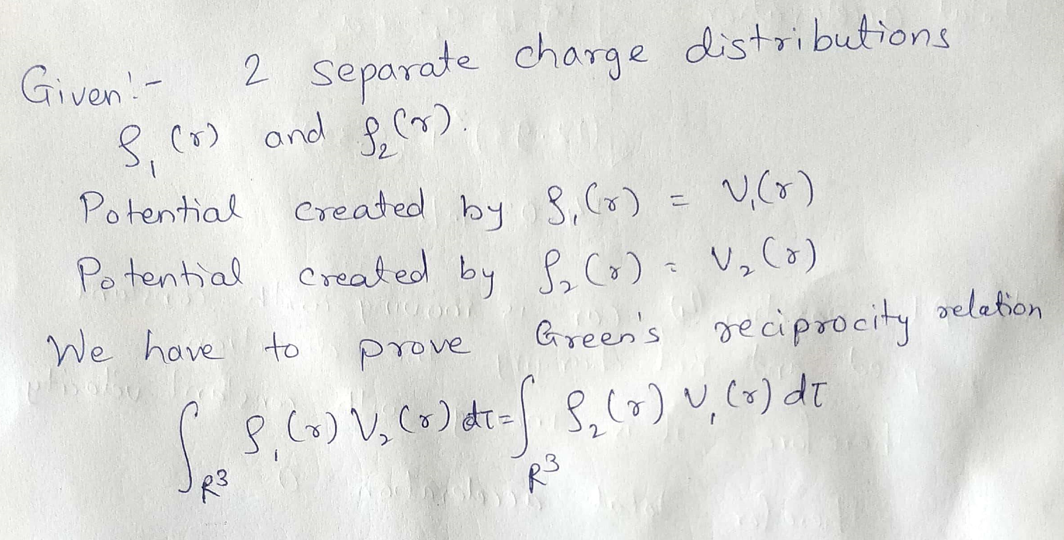Continuing from Problem 1(b), but now consider V to be the entire space (R) and S is at the infinity. Suppose we have two different localized charge distributions p1(r) and p2(r), which are NOT present in the space at the same time, and V1 and V2 are the electric potential generated by these two different charge distributions respectively. Using the Green's identity you showed in Problem 1(b), prove the Green's reciprocity relation Pi(") Va(r) dr = P2(r) Vi(r) dr R3
Continuing from Problem 1(b), but now consider V to be the entire space (R) and S is at the infinity. Suppose we have two different localized charge distributions p1(r) and p2(r), which are NOT present in the space at the same time, and V1 and V2 are the electric potential generated by these two different charge distributions respectively. Using the Green's identity you showed in Problem 1(b), prove the Green's reciprocity relation Pi(") Va(r) dr = P2(r) Vi(r) dr R3
Related questions
Question
Second pic is the answer to problem 1b for reference
![**Transcription of Mathematical Notes**
**Given:**
Let \( f(r) \) and \( g(r) \) be two scalar quantities. Then, we have to show:
\[
\int_V (g \nabla^2 f - f \nabla^2 g) \, dV = \oint_S (g \nabla f - f \nabla g) \cdot d\mathbf{a}
\]
**By Gauss's Theorem of Divergence:**
\[
\oint_S \mathbf{F} \cdot \mathbf{n} \, dS = \int_V \nabla \cdot \mathbf{F} \, dV
\]
So,
\[
\text{LHS: } \oint_S (g \nabla f - f \nabla g) \cdot d\mathbf{a} = \int_V \nabla \cdot (g \nabla f - f \nabla g) \, dV \quad \text{(i)}
\]
**We have:**
\[
\nabla g = \frac{\partial g}{\partial x} \hat{i} + \frac{\partial g}{\partial y} \hat{j} + \frac{\partial g}{\partial z} \hat{k}
\]
\[
\nabla f = \frac{\partial f}{\partial x} \hat{i} + \frac{\partial f}{\partial y} \hat{j} + \frac{\partial f}{\partial z} \hat{k}
\]
**Divergence Calculation:**
\[
\text{div}(f \nabla g) = f \left( \frac{\partial^2 g}{\partial x^2} \hat{i} + \frac{\partial^2 g}{\partial y^2} \hat{j} + \frac{\partial^2 g}{\partial z^2} \hat{k} \right)
+ \left( \frac{\partial f}{\partial x} \frac{\partial g}{\partial x} + \frac{\partial f}{\partial y} \frac{\partial g}{\partial y} + \frac{\partial f}{\partial z} \frac{\partial g}{\partial z} \right)
\]
\[
=\ f\left(\frac{\partial^2](/v2/_next/image?url=https%3A%2F%2Fcontent.bartleby.com%2Fqna-images%2Fquestion%2F0d2fdd51-a813-4b36-89e9-f9581acfc2ee%2F9f7120fd-abf0-4ae1-aabe-613f288dc72e%2F5y265ah_processed.jpeg&w=3840&q=75)
Transcribed Image Text:**Transcription of Mathematical Notes**
**Given:**
Let \( f(r) \) and \( g(r) \) be two scalar quantities. Then, we have to show:
\[
\int_V (g \nabla^2 f - f \nabla^2 g) \, dV = \oint_S (g \nabla f - f \nabla g) \cdot d\mathbf{a}
\]
**By Gauss's Theorem of Divergence:**
\[
\oint_S \mathbf{F} \cdot \mathbf{n} \, dS = \int_V \nabla \cdot \mathbf{F} \, dV
\]
So,
\[
\text{LHS: } \oint_S (g \nabla f - f \nabla g) \cdot d\mathbf{a} = \int_V \nabla \cdot (g \nabla f - f \nabla g) \, dV \quad \text{(i)}
\]
**We have:**
\[
\nabla g = \frac{\partial g}{\partial x} \hat{i} + \frac{\partial g}{\partial y} \hat{j} + \frac{\partial g}{\partial z} \hat{k}
\]
\[
\nabla f = \frac{\partial f}{\partial x} \hat{i} + \frac{\partial f}{\partial y} \hat{j} + \frac{\partial f}{\partial z} \hat{k}
\]
**Divergence Calculation:**
\[
\text{div}(f \nabla g) = f \left( \frac{\partial^2 g}{\partial x^2} \hat{i} + \frac{\partial^2 g}{\partial y^2} \hat{j} + \frac{\partial^2 g}{\partial z^2} \hat{k} \right)
+ \left( \frac{\partial f}{\partial x} \frac{\partial g}{\partial x} + \frac{\partial f}{\partial y} \frac{\partial g}{\partial y} + \frac{\partial f}{\partial z} \frac{\partial g}{\partial z} \right)
\]
\[
=\ f\left(\frac{\partial^2
![Continuing from Problem 1(b), but now consider \(\mathcal{V}\) to be the entire space (\(\mathbb{R}^3\)) and \(S\) is at infinity. Suppose we have two different *localized* charge distributions \(\rho_1(r)\) and \(\rho_2(r)\), which are NOT present in the space at the same time, and \(V_1\) and \(V_2\) are the electric potential generated by these two different charge distributions respectively. Using the Green's identity you showed in Problem 1(b), prove the Green's reciprocity relation
\[
\int_{\mathbb{R}^3} \rho_1(r) V_2(r) \, d\tau = \int_{\mathbb{R}^3} \rho_2(r) V_1(r) \, d\tau
\]](/v2/_next/image?url=https%3A%2F%2Fcontent.bartleby.com%2Fqna-images%2Fquestion%2F0d2fdd51-a813-4b36-89e9-f9581acfc2ee%2F9f7120fd-abf0-4ae1-aabe-613f288dc72e%2Fu9nq65b_processed.jpeg&w=3840&q=75)
Transcribed Image Text:Continuing from Problem 1(b), but now consider \(\mathcal{V}\) to be the entire space (\(\mathbb{R}^3\)) and \(S\) is at infinity. Suppose we have two different *localized* charge distributions \(\rho_1(r)\) and \(\rho_2(r)\), which are NOT present in the space at the same time, and \(V_1\) and \(V_2\) are the electric potential generated by these two different charge distributions respectively. Using the Green's identity you showed in Problem 1(b), prove the Green's reciprocity relation
\[
\int_{\mathbb{R}^3} \rho_1(r) V_2(r) \, d\tau = \int_{\mathbb{R}^3} \rho_2(r) V_1(r) \, d\tau
\]
Expert Solution
Step 1

Step by step
Solved in 2 steps with 3 images
